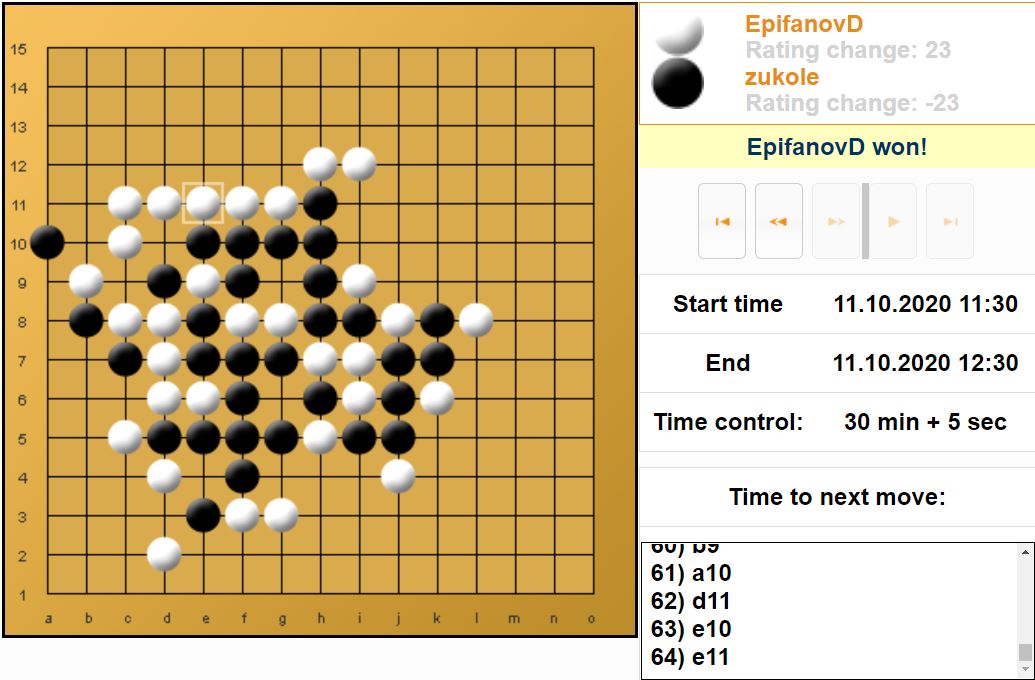On October 10-11, vint.ee hosted an international tournament organized by China as part of the 8th China International Qi (Mind Sport) Culture Exposition. This is the first such experiment, and the results are generally very positive. There were about eighty participants, and although many skilled european renju players ignored the competition, it was definitely tense. This tension was facilitated by both the shortened time control of 30 mins per game and the small number of rounds, there were only 7.
Before the start I had a choice, to play or to stream from the side. My personal circumstances turned out to be such that with the stream, especially on the second day, there would have been a lot of difficulties. More, rapid time control fits serious play better than streaming, so I decided to play.
I probably won’t talk about the whole tournament, I will tell you about just one important game. Click here to watch it on the playing site.
6th round, two leaders with 6 out of 6 – me and Michał Żukowski from Poland. He makes the first move, so I can choose an opening. He plays diagonal 2nd move, and I am tormented for a long time with the question: which opening to put? Sometimes I use a random numbers generator before the game to choose an opening, but this game is very important, the key one in the tournament for both of us, and I want to play without annoying surprises. The strategy of “letting the opponent put an opening with my 4th move” isn’t that good either: I still have a fresh and bleeding memory of how Michał completely outplayed me in i6 in the Renju Euroleague one year ago. That is why I decide to put something reliable, and what could be more reliable than an opening where I just lost several games in the renju world championship via correspondence?! So I open with i10.
After thinking, Michał proposes 4th move. I know some variants here, so I swap (vint.ee says I’ve spent mostly a minute but I felt like I’ve spent 10 seconds maximum). Michał proposes 5th move, not so familiar to me: my knowledge is limited to one variation, a game that Hao Tianyi won on renjuoffline a while ago. So I take white. 7, 8, 9, 10 are expected, and 11th is completely new for me. So my homework for next weeks is to give this 5th move a serious analysis and now I try to gently parry everything, calming down the position.
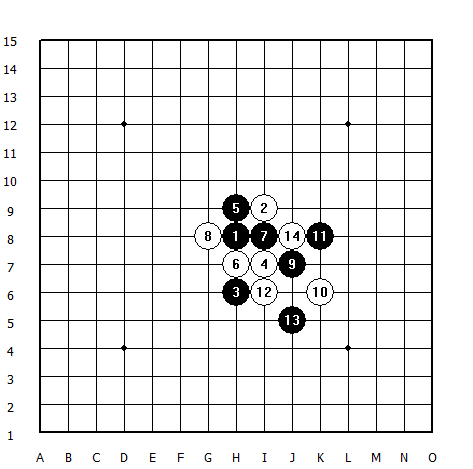
After the 14th move, I’d assess the position as follows: Black should not have a decisive development, but a talented black-oriented player will find it very promising. The eyes diverge from the possibilities from above: banal f9, optimistic f10, far e10, neat h10, harnessing g11 – there is a plenty options to choose from! But Michał prefers 15-g7, which is completely unexpected for me. This point does not look very valuable for White already so it’s clear that the goal of this move is combined, both attack preparation and defence. But if your opponent offers you to take the tempo – use it! And without much thought, having checked only that there is a VCT threat, I play 16th.
I am going to close the possible three to i5 from below (and expect it). But Michał plays carefully, closing an important line. It is not easy for White to support the initiative from above: there is only one pair, and if you ise it directly, it just disappears. Therefore, the basic plan for attack is to surround black stones slowly – e9. In response, Michał plays a three in i5. During the game, it seemed to me that this three was timed badly, but now I tend to agree with Michał’s choice. And after the planned closure, he removes my pair by playing a stone to k7.
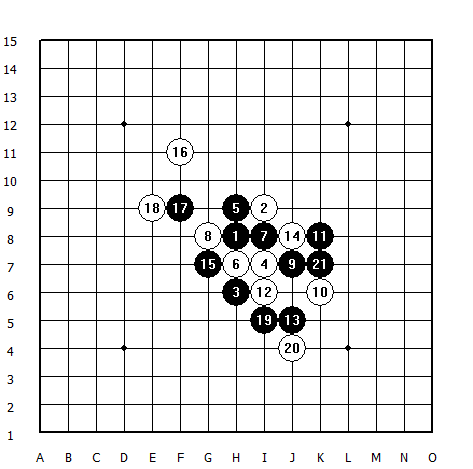
The position on the board may seem simple now, but this feeling is deceiving, it is very complicated. My first impulse is to move to j6 – a reliable, strong, simple defense. But then I will put up with the loss of the initiative, I will give the upper flank to be mocked by Black (if they can actively surround my stones by starting an attack from below). On the other hand, I can’t find Black’s VCT threat. More, some years ago Ants told me some words about the fact that fear must be fought. More, bearing in mind that Michał’s Berger coefficient is noticeably higher, i.e. a draw should be in his favor, I decide to throw my stone on the upper flank trying to get the most out of it. Additionally I intercept some of Black’s resources, for example, the line f, it’s nice.
Black plays a three at j6. The main attack direction is to the left; it would seem that it is possible to play three to h4 too, but j6 can only be closed on the right, so White has less counterplay and Black gains more opportunities with such a three. I close this one, close the next three, and then cold shiver comes to me: I notice that for the planned closure of the VCF threat in h4, Black has a powerful VCF threat in d6. I quickly refute all defences except for a cut with a three to i4. But even this defence is very dangerous: Black repels a three with fours and has a lot of opportunities for developing an attack that I don’t control. Fortunately, there is an opportunity to close the current VCF threat in g3, removing this dangerous development. There remains a free diagonal black pair, but I have an intercept for it.
But Black’s position remains strong, and by the 28th-30th move I deeply regret that I decided to ignore my opponent’s activity. My clock are showing 6-7 minutes left, Michał – about 12-15 minutes, and all his remainder he pushes in the search for win. Alas, the attack he found seems to be defendible because of faults. By late 30-s the situation looks trivial: either Black wins, right now, on the left, where a huge concentration of Black has been achieved, or the whole effort in vain, the black region will be surrounded, and White will inevitably win on the top flank.
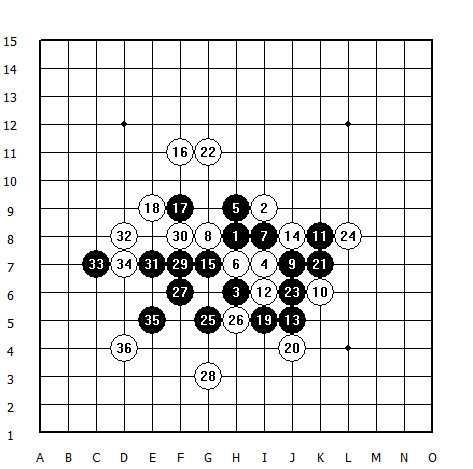
Michał puts a creative VCF threat to d5, but I succeed in finding a simple and clear defensive plan: four, three, the three has to be closed – and Black will have nothing left. And so it goes.
Did Black have a better move than d5? Could Black win somehow? I did not see anything suitable behind the board, a brief computer analysis after the game did not give anything positive either. Was there any development stronger than f6? Maybe. Several different VCF threats could be put, e5, for example, and it is quite possible that the refutation of the brave g11 is hidden somewhere there. Now that everything is over, I do not regret about g11; but in the process I regretted a lot.
Anyway, the game went on. Indeed, after 38, 40 Black is left with only the hopeless defense. By that time, I had not thought about realization for a moment. The only question to the top of the board was whether I can have an intercepting VCF and which stones may make it possible. My rival did not provide me with such a gorgeous counterplay, so I knew nothing about the upper side of the board, maybe some dogheads are living there. But then Black made some forcing moves, reducing my resources as much as possible, and made a defensive move 51.
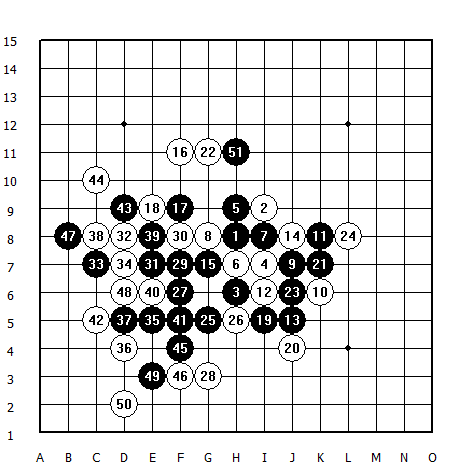
And imagine how many possibilities jumped into my eyes! But time is short, four minutes remained, so I had to take a most promising move and calculate it, right? And I decided that with the three sealed threes available, the opportunity to put three more sealed threes to c11 would hardly be bad. More, it’s easy to check the attack: there are two independent VCFs in 2 moves, which means that Black will have to outplay the diagonal four, and there another VCF for White will appear. Smooth on paper, but I was under heavy stress (and I had adrenaline in my blood, remember, just a few minutes ago Michał was killing me) so the lines mix, stones jump and wink. Barely managed.
Well, that’s all, the job was done. Thank you, Michał, a mutually devastating game it was!
P.S.
Click here to find full results of this tournament.
Written by Epifanov Dmitry, 2020.


